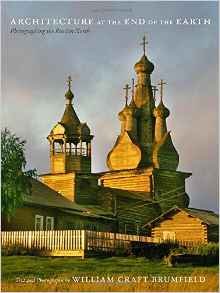Skrevet af BRUMFIELD
Carpeted in boreal forests, dotted with lakes, cut by rivers, and
straddling the Arctic Circle, the region surrounding the White Sea,
which is known as the Russian North, is sparsely populated and immensely
isolated. It is also the home to architectural marvels, as many of the
original wooden and brick churches and homes in the region's ancient
villages and towns still stand. Featuring nearly two hundred full color
photographs of these beautiful centuries-old structures, Architecture at the End of the Earth is the most recent addition to William Craft Brumfield's ongoing
project to photographically document all aspects of Russian
architecture.
The architectural masterpieces Brumfield
photographed are diverse: they range from humble chapels to grand
cathedrals, buildings that are either dilapidated or well cared for, and
structures repurposed during the Soviet era. Included are onion-domed
wooden churches such as the Church of the Dormition, built in 1674 in
Varzuga; the massive walled Transfiguration Monastery on Great
Solovetsky Island, which dates to the mid-1550s; the Ferapontov-Nativity
Monastery's frescoes, painted in 1502 by Dionisy, one of Russia's
greatest medieval painters; nineteenth-century log houses, both rustic
and ornate; and the Cathedral of St. Sophia in Vologda, which was
commissioned by Ivan the Terrible in the 1560s. The text that introduces
the photographs outlines the region's significance to Russian history
and culture.
Brumfield is challenged by the immense difficulty of
accessing the Russian North, and recounts traversing sketchy roads,
crossing silt-clogged rivers on barges and ferries, improvising travel
arrangements, being delayed by severe snowstorms, and seeing the region
from the air aboard the small planes he needs to reach remote areas.
The
buildings Brumfield photographed, some of which lie in near ruin, are
at constant risk due to local indifference and vandalism, a lack of
maintenance funds, clumsy restorations, or changes in local and national
priorities. Brumfield is concerned with their futures and hopes that
the region's beautiful and vulnerable achievements of master Russian
carpenters will be preserved. Architecture at the End of the Earth is at once an art book, a travel guide, and a personal document about
the discovery of this bleak but beautiful region of Russia that most
readers will see here for the first time.

